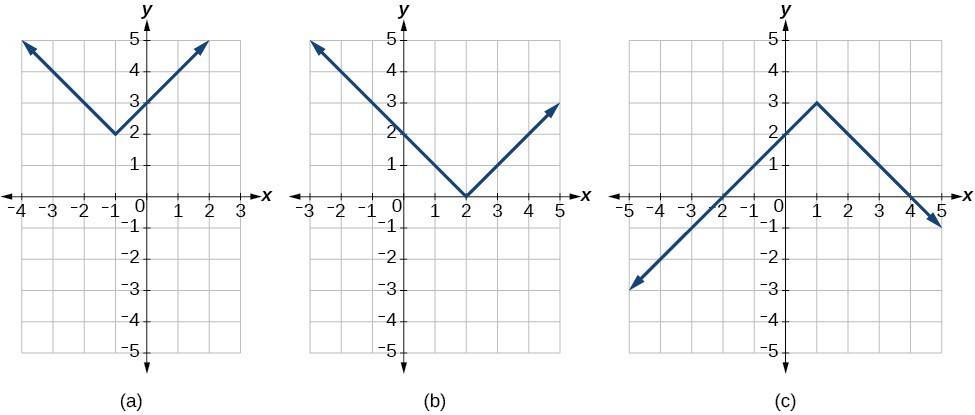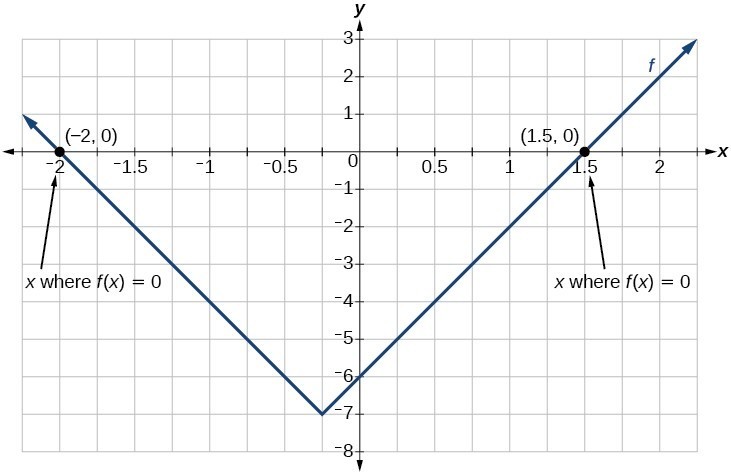Absolute Value Functions
Learning Outcomes
- Graph an absolute value function.
- Find the intercepts of an absolute value function.
 Distances in deep space can be measured in all directions. As such, it is useful to consider distance in terms of absolute values. (credit: "s58y"/Flickr)
Distances in deep space can be measured in all directions. As such, it is useful to consider distance in terms of absolute values. (credit: "s58y"/Flickr)Understanding Absolute Value
Recall that in its basic form [latex]\displaystyle{f}\left({x}\right)={|x|}[/latex], the absolute value function, is one of our toolkit functions. The absolute value function is commonly thought of as providing the distance a number is from zero on a number line. Algebraically, for whatever the input value is, the output is the value without regard to sign.A General Note: Absolute Value Function
The absolute value function can be defined as a piecewise function$latex f(x) =\begin{cases}x ,\ x \geq 0 \\ -x , x < 0\\ \end{cases} $
tip for success
It can help to visualize the graph of an absolute value function as the graph of the identity function, [latex]f(x) = x[/latex] where, for all negative input, the function value is forced to be positive. When describing absolute value in words, visualize it as a distance. We can see, for example, that the two values that are [latex]3[/latex] units away from the number [latex]1[/latex] on the number line are [latex]4[/latex] and [latex]-2[/latex]. We can use an absolute value function statement to describe this by asking the question what values are 3 units away from 1? Let [latex]x[/latex] be the numbers. That is, the distance from some number and 1 is 3.[latex]|x-1| = 3[/latex]
[latex] x-1 = 3 \quad \Rightarrow \quad x = 4 \qquad \text{ and } \qquad x-1 = -3 \quad \Rightarrow \quad x = -2[/latex]
Example: Determine a Number within a Prescribed Distance
Describe all values [latex]x[/latex] within or including a distance of 4 from the number 5.Answer:
 We want the distance between [latex]x[/latex] and 5 to be less than or equal to 4. We can draw a number line to represent the condition to be satisfied.
The distance from [latex]x[/latex] to 5 can be represented using [latex]|x - 5|[/latex]. We want the values of [latex]x[/latex] that satisfy the condition [latex]|x - 5|\le 4[/latex].
We want the distance between [latex]x[/latex] and 5 to be less than or equal to 4. We can draw a number line to represent the condition to be satisfied.
The distance from [latex]x[/latex] to 5 can be represented using [latex]|x - 5|[/latex]. We want the values of [latex]x[/latex] that satisfy the condition [latex]|x - 5|\le 4[/latex].
Analysis of the Solution
Note that [latex-display]\displaystyle{-4}\le{x - 5}[/latex-display] [latex-display]\displaystyle{1}\le{x}[/latex-display] And: [latex-display]\displaystyle{x-5}\le{4}[/latex-display] [latex-display]\displaystyle{x}\le{9}[/latex-display] So [latex]|x - 5|\le 4[/latex] is equal to [latex]1\le x\le 9[/latex]. However, mathematicians generally prefer absolute value notation.Try It
Describe all values [latex]x[/latex] within a distance of 3 from the number 2.Answer: [latex-display]|x - 2|\le 3[/latex-display]
[ohm_question]469[/ohm_question]Example: Resistance of a Resistor
Electrical parts, such as resistors and capacitors, come with specified values of their operating parameters: resistance, capacitance, etc. However, due to imprecision in manufacturing, the actual values of these parameters vary somewhat from piece to piece even when they are supposed to be the same. The best that manufacturers can do is to try to guarantee that the variations will stay within a specified range, often [latex]\pm 1\%,\pm5\%,[/latex] or [latex]\displaystyle\pm10\%[/latex]. Suppose we have a resistor rated at 680 ohms, [latex]\pm 5\%[/latex]. Use the absolute value function to express the range of possible values of the actual resistance.Answer: 5% of 680 ohms is 34 ohms. The absolute value of the difference between the actual and nominal resistance should not exceed the stated variability, so, with the resistance [latex]R[/latex] in ohms,
[latex]|R - 680|\le 34[/latex]
Try It
Students who score within 20 points of 80 will pass a test. Write this as a distance from 80 using absolute value notation.Answer: Using the variable [latex]p[/latex] for passing, [latex]|p - 80|\le 20[/latex].
 The graph below is of [latex]y=2\left|x - 3\right|+4[/latex]. The graph of [latex]y=|x|[/latex] has been shifted right 3 units, vertically stretched by a factor of 2, and shifted up 4 units. This means that the corner point is located at [latex]\left(3,4\right)[/latex] for this transformed function.
The graph below is of [latex]y=2\left|x - 3\right|+4[/latex]. The graph of [latex]y=|x|[/latex] has been shifted right 3 units, vertically stretched by a factor of 2, and shifted up 4 units. This means that the corner point is located at [latex]\left(3,4\right)[/latex] for this transformed function.

Example: Writing an Equation for an Absolute Value Function
Write an equation for the function graphed below.
Answer:
The basic absolute value function changes direction at the origin, so this graph has been shifted to the right 3 units and down 2 units from the basic toolkit function.
 We also notice that the graph appears vertically stretched, because the width of the final graph on a horizontal line is not equal to 2 times the vertical distance from the corner to this line, as it would be for an unstretched absolute value function. Instead, the width is equal to 1 times the vertical distance.
We also notice that the graph appears vertically stretched, because the width of the final graph on a horizontal line is not equal to 2 times the vertical distance from the corner to this line, as it would be for an unstretched absolute value function. Instead, the width is equal to 1 times the vertical distance.
 From this information we can write the equation
From this information we can write the equation
[latex]\begin{array}{l}f\left(x\right)=2\left|x - 3\right|-2,\hfill & \text{treating the stretch as a vertical stretch, or}\hfill \\ f\left(x\right)=\left|2\left(x - 3\right)\right|-2,\hfill & \text{treating the stretch as a horizontal compression}.\hfill \end{array}[/latex]
Analysis of the Solution
Note that these equations are algebraically the same—the stretch for an absolute value function can be written interchangeably as a vertical or horizontal stretch or compression.[latex]f\left(x\right)=a|x - 3|-2[/latex]
Now substituting in the point (1, 2)[latex]\begin{array}{l}2=a|1 - 3|-2\hfill \\ 4=2a\hfill \\ a=2\hfill \end{array}[/latex]
Try It
Write the equation for the absolute value function that is horizontally shifted left 2 units, vertically flipped, and vertically shifted up 3 units.Answer: [latex]f\left(x\right)=-|x+2|+3\\[/latex]
[ohm_question]60791[/ohm_question] (a) The absolute value function does not intersect the horizontal axis. (b) The absolute value function intersects the horizontal axis at one point. (c) The absolute value function intersects the horizontal axis at two points.
(a) The absolute value function does not intersect the horizontal axis. (b) The absolute value function intersects the horizontal axis at one point. (c) The absolute value function intersects the horizontal axis at two points.Find the Intercepts of an Absolute Value Function
Knowing how to solve problems involving absolute value functions is useful. For example, we may need to identify numbers or points on a line that are at a specified distance from a given reference point.How To: Given the formula for an absolute value function, find the horizontal intercepts of its graph.
- Isolate the absolute value term.
- Use [latex]|A|=B[/latex] to write [latex]A=B[/latex] or [latex]\mathrm{-A}=B[/latex], assuming [latex]B>0[/latex].
- Solve for [latex]x[/latex].
tip for success
The places where a graph crosses the horizontal axis are sometimes called horizontal intercepts, x-intercepts, or zeros. We call them zeros because those are the places where the function value equals zero. To find them, set the function value equal to zero and solve for [latex]x[/latex]. We can do this for many functions using the techniques of college algebra.Example: Finding the Zeros of an Absolute Value Function
For the function [latex]f\left(x\right)=|4x+1|-7[/latex] , find the values of [latex]x[/latex] such that [latex]\text{ }f\left(x\right)=0[/latex] .Answer:
[latex]\begin{array}{l}0=|4x+1|-7\hfill & \hfill & \hfill & \hfill & \hfill & \hfill & \text{Substitute 0 for }f\left(x\right).\hfill \\ 7=|4x+1|\hfill & \hfill & \hfill & \hfill & \hfill & \hfill & \text{Isolate the absolute value on one side of the equation}.\hfill \\ \hfill & \hfill & \hfill & \hfill & \hfill & \hfill & \hfill \\ \hfill & \hfill & \hfill & \hfill & \hfill & \hfill & \hfill \\ \hfill & \hfill & \hfill & \hfill & \hfill & \hfill & \hfill \\ 7=4x+1\hfill & \text{or}\hfill & \hfill & \hfill & \hfill & -7=4x+1\hfill & \text{Break into two separate equations and solve}.\hfill \\ 6=4x\hfill & \hfill & \hfill & \hfill & \hfill & -8=4x\hfill & \hfill \\ \hfill & \hfill & \hfill & \hfill & \hfill & \hfill & \hfill \\ x=\frac{6}{4}=1.5\hfill & \hfill & \hfill & \hfill & \hfill & \text{ }x=\frac{-8}{4}=-2\hfill & \hfill \end{array}[/latex]
 The function outputs 0 when [latex]x=1.5[/latex] or [latex]x=-2[/latex].
The function outputs 0 when [latex]x=1.5[/latex] or [latex]x=-2[/latex].
Try It
For the function [latex]f\left(x\right)=|2x - 1|-3[/latex], find the values of [latex]x[/latex] such that [latex]f\left(x\right)=0[/latex].Answer: [latex]x=-1[/latex] or [latex]x=2[/latex]
[ohm_question]40657[/ohm_question]Licenses & Attributions
CC licensed content, Original
- Revision and Adaptation. Provided by: Lumen Learning License: CC BY: Attribution.
CC licensed content, Shared previously
- Precalculus. Provided by: OpenStax Authored by: Jay Abramson, et al.. Located at: https://openstax.org/books/precalculus/pages/1-introduction-to-functions. License: CC BY: Attribution. License terms: Download For Free at : http://cnx.org/contents/[email protected]..
- College Algebra. Provided by: OpenStax Authored by: Abramson, Jay et al.. License: CC BY: Attribution. License terms: Download for free at http://cnx.org/contents/[email protected].
- Question ID 469. Authored by: WebWork-Rochester, mb Lippman,David. License: CC BY: Attribution. License terms: IMathAS Community License CC-BY + GPL.
- Question ID 60791. Authored by: Day, Alyson. License: CC BY: Attribution. License terms: IMathAS Community License CC-BY + GPL.
- Question ID 40657. Authored by: Jenck,Michael. License: CC BY: Attribution. License terms: IMathAS Community License CC-BY + GPL.

